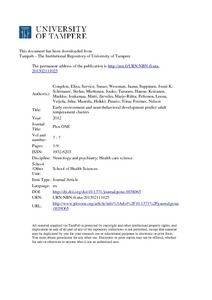Early environment and neurobehavioral development predict adult temperament clusters
Congdon, Eliza; Service, Susan; Wessman, Jaana; Seppänen, Jouni K; Schönauer, Stefan; Miettunen, Jouko; Turunen, Hannu; Koiranen, Markku; Joukamaa, Matti; Järvelin, Marjo-Riitta; Peltonen, Leena; Veijola, Juha; Mannila, Heikki; Paunio, Tiina; Freimer, Nelson (2012)
Congdon, Eliza
Service, Susan
Wessman, Jaana
Seppänen, Jouni K
Schönauer, Stefan
Miettunen, Jouko
Turunen, Hannu
Koiranen, Markku
Joukamaa, Matti
Järvelin, Marjo-Riitta
Peltonen, Leena
Veijola, Juha
Mannila, Heikki
Paunio, Tiina
Freimer, Nelson
2012
Plos ONE 7 7
1-9
Terveystieteiden yksikkö - School of Health Sciences
This publication is copyrighted. You may download, display and print it for Your own personal use. Commercial use is prohibited.
Julkaisun pysyvä osoite on
https://urn.fi/URN:NBN:fi:uta-201302111025
https://urn.fi/URN:NBN:fi:uta-201302111025
Kuvaus
Public Library of Science open access
Tiivistelmä
Background
Investigation of the environmental influences on human behavioral phenotypes is important for our understanding of the causation of psychiatric disorders. However, there are complexities associated with the assessment of environmental influences on behavior.
Methods/Principal Findings
We conducted a series of analyses using a prospective, longitudinal study of a nationally representative birth cohort from Finland (the Northern Finland 1966 Birth Cohort). Participants included a total of 3,761 male and female cohort members who were living in Finland at the age of 16 years and who had complete temperament scores. Our initial analyses (Wessman et al., in press) provide evidence in support of four stable and robust temperament clusters. Using these temperament clusters, as well as independent temperament dimensions for comparison, we conducted a data-driven analysis to assess the influence of a broad set of life course measures, assessed pre-natally, in infancy, and during adolescence, on adult temperament.
Results
Measures of early environment, neurobehavioral development, and adolescent behavior significantly predict adult temperament, classified by both cluster membership and temperament dimensions. Specifically, our results suggest that a relatively consistent set of life course measures are associated with adult temperament profiles, including maternal education, characteristics of the family’s location and residence, adolescent academic performance, and adolescent smoking.
Conclusions
Our finding that a consistent set of life course measures predict temperament clusters indicate that these clusters represent distinct developmental temperament trajectories and that information about a subset of life course measures has implications for adult health outcomes.
Investigation of the environmental influences on human behavioral phenotypes is important for our understanding of the causation of psychiatric disorders. However, there are complexities associated with the assessment of environmental influences on behavior.
Methods/Principal Findings
We conducted a series of analyses using a prospective, longitudinal study of a nationally representative birth cohort from Finland (the Northern Finland 1966 Birth Cohort). Participants included a total of 3,761 male and female cohort members who were living in Finland at the age of 16 years and who had complete temperament scores. Our initial analyses (Wessman et al., in press) provide evidence in support of four stable and robust temperament clusters. Using these temperament clusters, as well as independent temperament dimensions for comparison, we conducted a data-driven analysis to assess the influence of a broad set of life course measures, assessed pre-natally, in infancy, and during adolescence, on adult temperament.
Results
Measures of early environment, neurobehavioral development, and adolescent behavior significantly predict adult temperament, classified by both cluster membership and temperament dimensions. Specifically, our results suggest that a relatively consistent set of life course measures are associated with adult temperament profiles, including maternal education, characteristics of the family’s location and residence, adolescent academic performance, and adolescent smoking.
Conclusions
Our finding that a consistent set of life course measures predict temperament clusters indicate that these clusters represent distinct developmental temperament trajectories and that information about a subset of life course measures has implications for adult health outcomes.
Kokoelmat
- Artikkelit [6140]
